The Battle of Midway Roundtable Opening Remarks

Welcome to the Battle of Midway RoundTable. This month we have a number of articles on the 80th Anniversary of the Battle of Midway, June 3 to June 7, 1942. We also have two book reviews and an article on the Battle of Midway from the USNI Naval History magazine.
There are always many events around the country celebrating the anniversary of the battle on or around June 4th. Not as many as there once was which is sad as not as many people learn about the battle or the significance of it in our own history. It is probably inevitable as time passes that some organizations cannot gather enough support to warrant holding an event. And that has certainly been curtailed in the last few years due to the pandemic. But for the ones that continue we are very grateful.
This weekend is Memorial day where we remember not only the many who did not return from the Battle of Midway but the many others that made the ultimate sacrifice for us.
THE BATTLE OF MIDWAY AT EIGHTY
The Battle of Gettysburg, 1863, one hundred and fifty-nine years ago: very few events in U.S. history were so important in determining the nation’s future. Had the battle gone the other way—and it very well could have, possibly should have according to some analyses—the war’s ultimate outcome would probably have been the same, but it would not have ended as early as it did and not without a terrible additional price to be paid on both sides.
Comparing the Battle of Midway to the Battle of Gettysburg reveals a number of similarities. Confederate armies mostly had their way early in the Civil War, until “victory disease” tempted them to try a decisive 3-day battle that turned out to be their Bridge Too Far. From that point forward, the Federals were on offense and the Confederates on defense, with the only question being how long it would take to reach the inevitable conclusion.
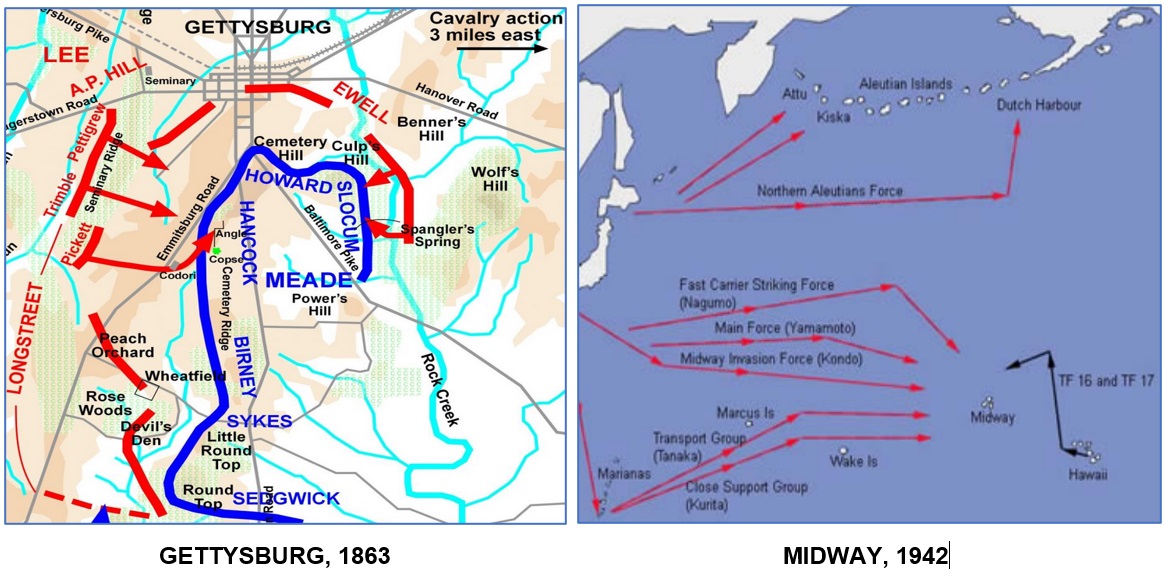
That should all sound very familiar. World War II in the Pacific began pretty much the same way, culminating in a 3-day battle at Midway that put an enemy infected with victory disease on defense for the rest of the war. However, there is one aspect of the BOM that stands in stark contrast to Gettysburg: everything that happened at Gettysburg was known down to the last important detail almost immediately. Midway has turned out to be quite the opposite, with its body of knowledge expanding and even occasionally changing dramatically with each passing decade.
The battle was first defined in detail for the public in the 1950s, in volume 4 of Morison’s History of United States Naval Operations in World War II. While Morison described the events of 3 - 7 June around Midway well enough, there was no mention at all of the critical role played by radio intelligence because that would not be declassified for years to come. Walter Lord’s Incredible Victory gave us the first of those details in 1967, the 25th anniversary, thereby revealing for the first time that the battle was not won solely by the bravery and sacrifice of the men at the point of the spear.
Then in the 1980s, at about the time of the 40th anniversary, Bowen Weisheit noticed something odd about an obscure artifact from the battle, which eventually led to the revelation that one key piece of the Navy’s official history of the BOM was embarrassingly wrong. That ignited a history-changing controversy that continues to this day concerning the role pf the USS Hornet air group on the first day of the battle.
As the 60th anniversary came and went, history was changed yet again with Jon Parshall and Tony Tully’s news that the accepted Japanese version of the battle was even less believable than the U.S. Navy’s account of the Hornet air group. If only the SBDs had appeared just a few minutes later, said the much-honored IJN veteran Mitsuo Fuchida, Japanese carriers would have launched a killing strike, with bombers ready to go on their flight decks, as seen is this excerpt from the cover of A Glorious Day In Our History...except that Jon and Tony were able to demonstrate that all four flight decks were empty save a few CAP fighters; the bombers were all loaded and fueled on the hangar decks; not remotely ready to launch.
|
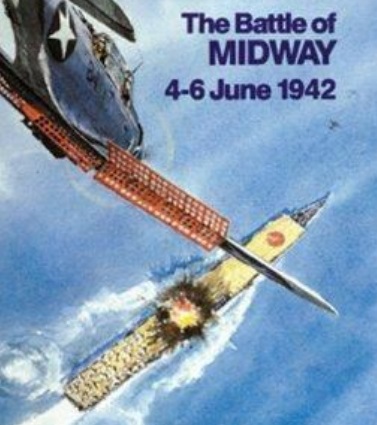
|
It was the same at the 65-year mark as Dallas Isom, in Midway Inquest, took a look at the likely flight time and track of IJN cruiser Tone’s #4 scout plane and concluded that its 30-minute launch delay—long believed to have worked against Japanese chances for victory—turned out to be the reason that its pilot sighted any U.S. ships at all. Had #4 launched on schedule, its intended route would have bypassed the American fleet entirely, with the likely result that Yorktown would have escaped the initial attack that led to its loss. History is changed again.
And so it goes as the BOM passes its eighth decade: what we know of it refuses to remain static, in contrast to virtually any other history-defining battle in U.S. military annals like Gettysburg. What else will be revealed to us by the time we celebrate the fluid story of Midway on the occasion of its ninth decade in 2032?
—Thom Walla
—Ron Russell
28 May 2022
NAVAL HISTORY MAGAZINE ANNIVERSARY ARTICLE, FREE ONLINE
The U.S. Naval Institute’s Naval History magazine has a fine 80th anniversary article by Jon Parshall in its current (June) issue, and contrary to USNI’s usual practice, it’s freely available online. You can click this URL to open and read it:
https://www.usni.org/magazines/naval-history-magazine/2022/june/timeless-battle-evolving-interpretations
Jon’s article isn’t simply a retelling of the BOM—instead, he presents a summary of how the battle’s known history has evolved in recent years, in light of various new findings and analyses that are quite familiar here. In fact, the article could very well serve as a summary of the past 24 years on the Battle of Midway Roundtable, during which we’ve seen our veterans, historians, and authors deliver an understanding of the BOM that was previously unknown.
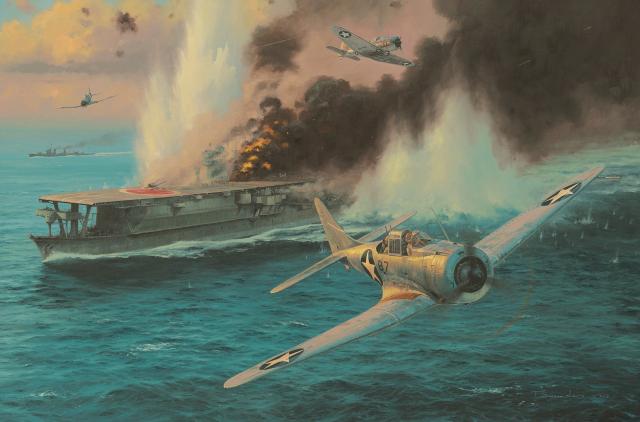
The above image of a VB-3 Dauntless crossing the bow of Soryu is a two-page spread in the magazine. For those who like to try spotting inaccuracies in BOM artwork: see if you can find at least one thing quite wrong with this particular SBD and possibly one or two other questionable issues. Thanks in advance to everyone who submits a plausible answer; we’ll have them all in our next newsletter.
BOM-80 AT THE NAVAL AVIATION MUSEUM, PENSACOLA
The following news arrived too late to include in the list of BOM-80 events in our May 20th bulletin. The National Museum of Naval Aviation at Pensacola, Florida will be open on Saturday, June 4th, for a special 80th anniversary event. This is significant, since the museum is located within the Pensacola Naval Air Station. The NAS has been closed to the general public for an extended period due to security and pandemic issues. It will have a limited opening on the 4th for access to the museum.
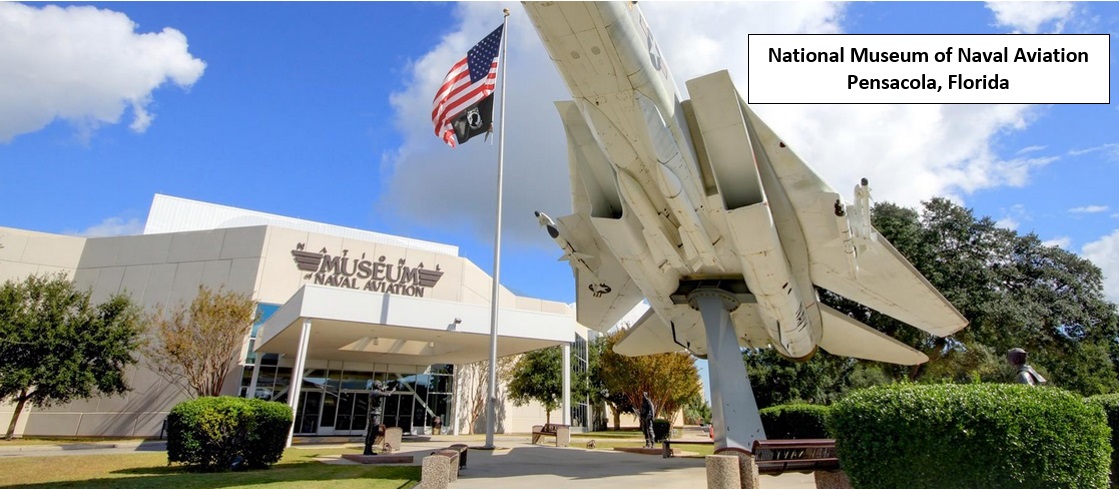
See the link below for their announcement concerning the event, which is certain to be worth your time and travel. The museum itself is awesome on any day, and the addition of a Midway anniversary program will be a bonus. Beyond that, plan on spending additional time there checking the massive aircraft collection and static displays. You won’t be disappointed. Here is the museum’s website and their BOM-80 announcement:
https://www.navalaviationmuseum.org/
https://www.navalaviationmuseum.org/event/festival-of-flight/
Many thanks to Roundtable contributor Bill Longton in Florida for his persistence in getting this information for us—it was not a simple task. BZ, Bill.
BOM-80: A SMALL SUCCESS STORY
We’re happy to acknowledge Roundtable member Grieg Seidor for conducting what may have been the first 80th anniversary commemoration event. Here’s his report on a lecture and PowerPoint show, based mainly on Shattered Sword, that he presented for a small audience at his local public library near Chicago. BZ, Grieg!
____________________
20 May 2022
From: Greg Seidor
Illinois
My presentation on the Battle of Midway took place for about 2 hours at the Geneva (IL) Public Library on the afternoon of May 17th. There were 20 people in attendance and, from what I could tell, the audience seemed interested and engaged. There were several questions from the audience. Audience was largely male, all over the age of 40. I am not sure about veterans (though I do know that at least one was a retired Navy reserves man).
____________________
NEW HORNET PHOTO AND VIDEO
If you’re a Facebook user, you may be interested in joining the USS Hornet CV-8 group. That’s where I found the interesting dockside photo of the ship at Norfolk in February 1942 (see our
September 2021 newsletter). Here’s another from the Facebook group that appears to be a different angle of the same scene. Note the F4Fs and SBC biplanes on the flight deck.
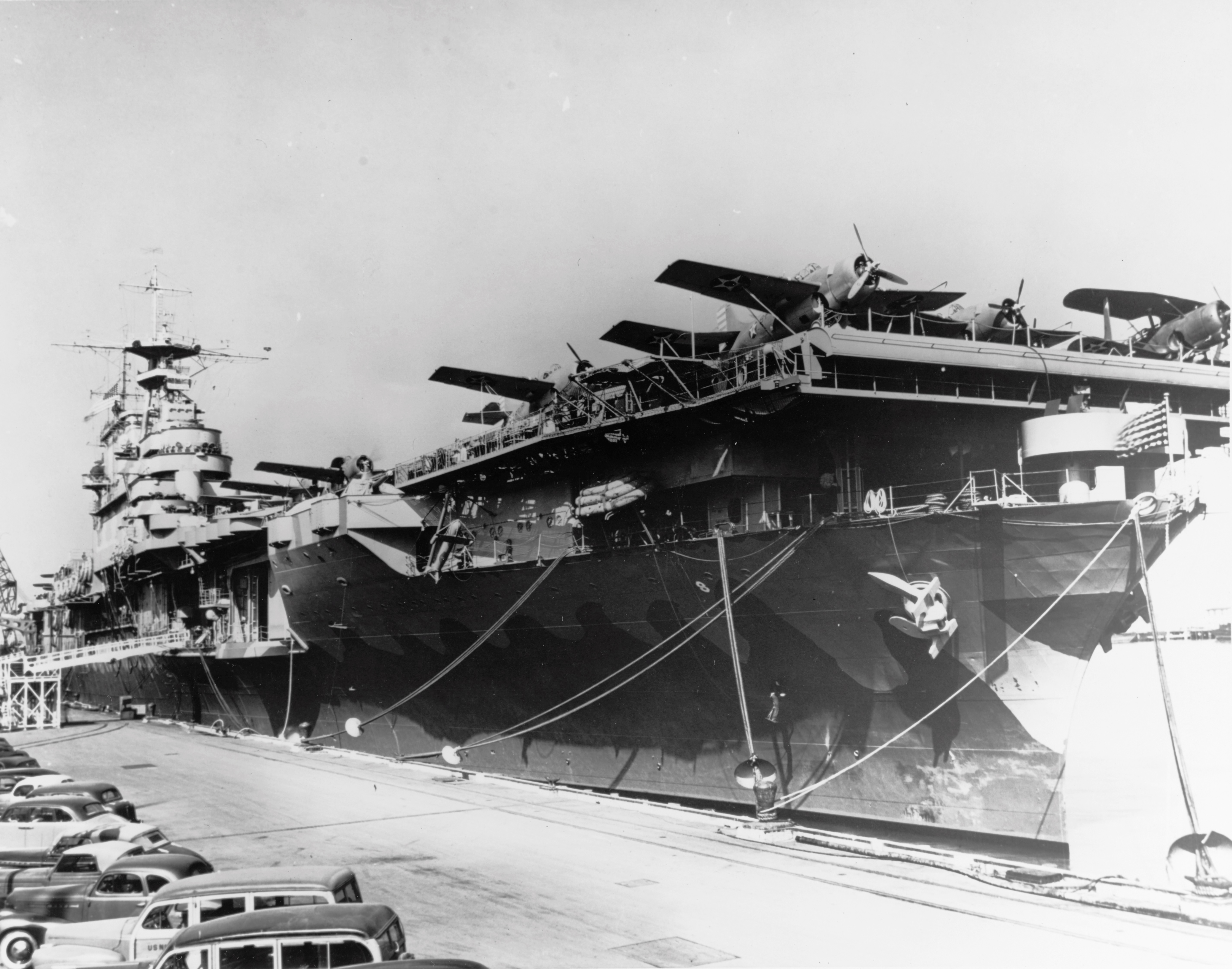
The Facebook group also led us to a wartime documentary on the Hornet that was entirely new to me, despite being almost as old. It’s “The Life and Death of the USS Hornet,” a 16-minute Youtube that provides a good overview of the ship’s one year and six days of operations, with authentic film clips that weren’t concocted in a Hollywood studio. Give it a look here:
https://www.youtube.com/watch?v=92xlRfbiPPU
—RR
IS THIS ZERO ABOUT TO LAUNCH?
...or must it wait for the overhead sun to melt away more of the fog before its pilot in the cockpit can crank the engine and head out on the long flight to Guadalcanal, escorting a flight of G4M (Betty) bombers?
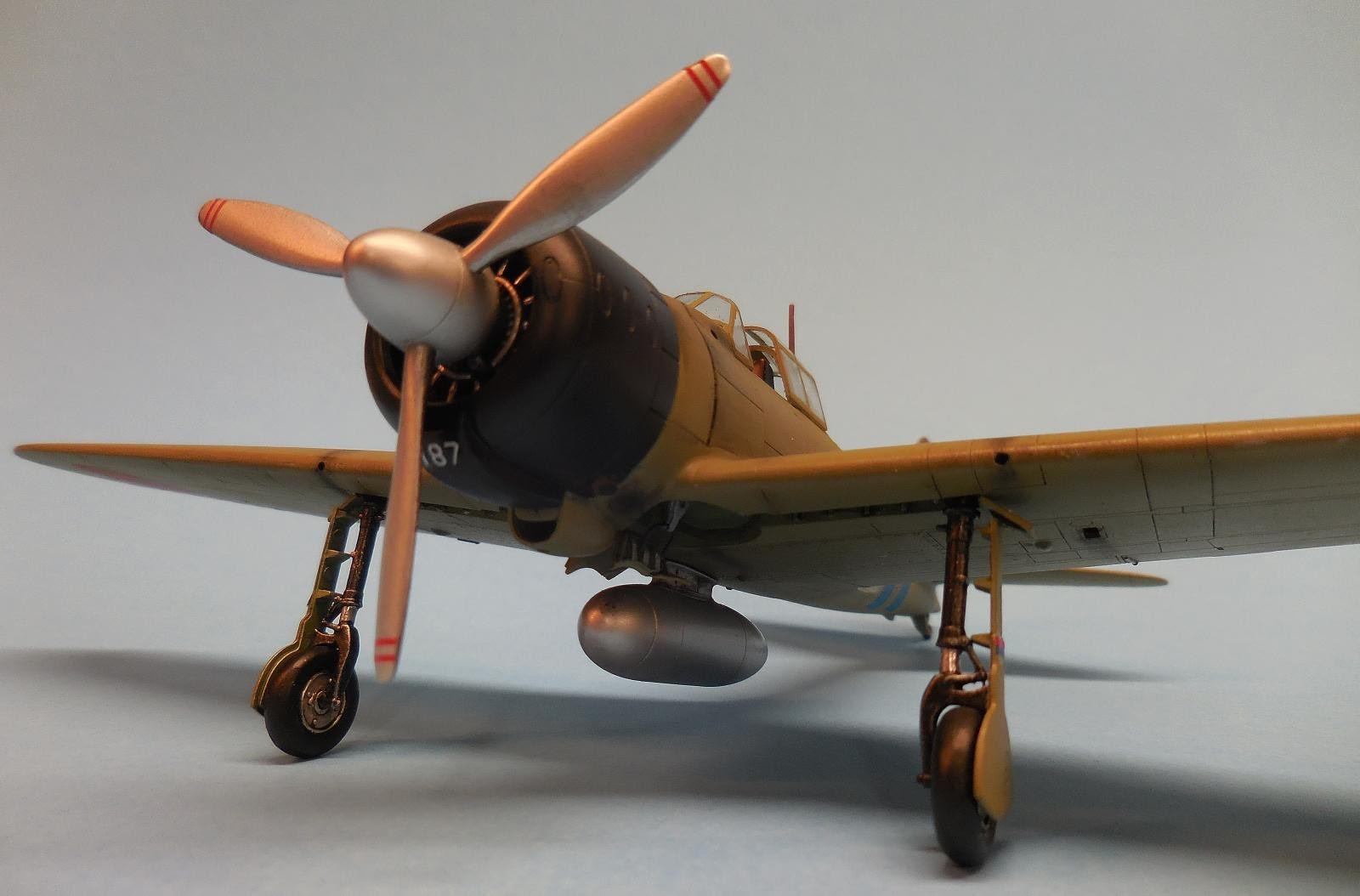
Or, instead of a combat-ready A6M Zero fighter ready for action, is this actually a very realistic 1:48 scale model? It looks quite enough like the real thing—check the burn marks around the 20 mm cannon ports and the exhaust stain trailing aft from the pipe near the left wing root.
(Like most of the images inserted in our newsletters, you can get a much larger, high-resolution view by right-clicking the middle of the picture, then open it in another browser tab or download it to your image app.)
Seriously, this Zero was crafted by scale modeler and Roundtable member Fred Seitz in Florida—great job, Fred. (And if this was the real thing, it wouldn’t be preparing to duel the Cactus Air Force on Guadalcanal as suggested above—the plane is painted and marked to the last detail like that of Soryu pilot Takeo Sugiyama, neither of whom made it back from Midway.)
Fred has several more authentic Midway models in his hangar, and we may see more of them in future newsletters.
TWO NEW MIDWAY BOOKS
It seems I say this with every new BOM book that I review: why does anyone think there is anything that needs to be said about the battle that hasn’t already been said, usually rather well by eminently capable historians? Of course, it continues to happen and the books keep coming, from groundbreaking icons like Shattered Sword (2005) to the other end of the scale like the abysmal The Eagle’s Claw (2021). This month we have two that land somewhere in the middle of that scale.
The first initially struck me as a bit pretentious: author Henry James, in The Man Who Won World War II, wants us to believe that the accomplishments of Joseph Rochefort were singularly responsible for the chain of events that brought the allied victory in 1945 in both the Pacific and European theaters. In the absence of Rochefort’s achievements, all subsequent world history would have been miserably worse as viewed today. The author is basically expanding on the
James Schlessinger theme, but does so with thorough research and a convincing level of detail that no one else has bothered to flesh out.
Had the U.S. been blindsided at Midway without Rochefort’s critical advantage, CINCPAC’s options would have been cruelly limited. Remember, for example, that at the end of May 1942, with no known reason to rush the battered Yorktown into another campaign, the ship simply heads to Bremerton for its planned Coral Sea repairs. That would have left only Enterprise and Hornet available to deal with Kido Butai off Midway, much too late and on the wrong side of an IJN submarine screen. Nothing good comes of that, nor of the other inevitable conditions the allies face as postulated by Schlessinger.
I recommend the book to the Roundtable as a thought-provoking, well-crafted 226-page essay on how Joseph Rochefort almost single-handedly determined the future of the world after June of 1942. The 6 x 9 inch paperback is a bargain at only $6.00, and no, I don’t get anything for recommending it. Four stars out of five.
- - - - -
The second new offering this month is The Silver Waterfall by two U.K. authors, Brendan Simms and Steven McGregor. In my opinion, their book has a problem coming out of the gate: its title copies that of another BOM book that we featured on the Roundtable only two years ago in our
May 2010 newsletter, Kevin Miller’s commendable Midway novel. Interestingly, the authors even cite Miller’s book in their text (page 233), although they don’t quite have his title correct, which I found rather curious since it’s exactly the same as theirs.
Of course, titles cannot be copyrighted and we’ve seen this before, with Charles Mercer’s Miracle at Midway in 1977. The same title was then co-opted in 1982 by Gordon Prange with far more success.
Enough about the title; the book itself is a mixed bag. A little over half simply retells the Battle of Midway, thus failing my challenge at the beginning of this article. (Heads up for any more budding BOM authors out there: if you’re going to write something about the Battle of Midway, don’t simply relate the Battle of Midway—that’s been done.)
The book’s saving grace, then, is the abundant backstory it provides on why the U.S. was able to prevail at Midway, especially with regard to the achievements of Ed Heineman at Douglas Aircraft Company, the producer of the SBD Dauntless. Heineman’s accomplishments and those of other American industrial masters are woven throughout the text, helping to illustrate that victory at Midway was the result of much more than the courage and talents of men in uniform. That element is highly interesting, well researched, and previously not known to the average BOM reader.
The Silver Waterfall ends with an extensive treatise on modern issues facing the U.S. in the Pacific, particularly with regard to any potential naval conflict with China. That topic is also well researched and well written, but one might reasonably wonder if it actually doesn’t belong in a different book—the departure from this one’s core subject is a bit much.
Bottom line: some new information that’s worth knowing, some more that you already know, no photographs, few illustrations, and an ending that seems to be in the wrong book. At least the authors are generally accurate as to the facts of the BOM, although they have the Hornet as the only surviving U.S. carrier (page 243). Two and half stars.
—RR

While looking around the NHHC website some time back, Bill Longton found the flight log of VT-8 pilot LTjg Jeff Woodson. His handwritten final entry just before launch is yet another poignant reminder of his squadron’s bitter destiny: “Date: 4 June 1942. Mission: Torpedo attack.” You can view it here:
https://www.history.navy.mil/our-collections/artifacts/ephemera/books/flight-log-of-ltjg-jeff-davis-woodson-mia-battle-of-midway.html
* * * * * *
As mentioned in the May 20th bulletin, we salute all those individuals and organizations that will conduct any sort of 80th anniversary commemoration, whether major or minor, public or private, civilian or military. Even so, it’s regrettable that so many military and military-related commands and organizations have had to cancel or limit their observance for yet another year due to pandemic precautions or in some cases security issues.
Meanwhile, BOM-80 is happening at many locations as listed in the bulletin, and no doubt at many others that didn’t come to our attention. If you attend or observe any such event, please send in a report plus any photos that you can share.
* * * * * *
With nearly 500 subscribers world wide, it’s inevitable that we’ll continue to have a few email problems with everything we send out. Repeating a recent suggestion, you can help us minimize those monthly email failures by making us a preferred contact in your email app. In your Contacts or Address Book (depending on your app), create a personal contact for the Roundtable. You might enter it this way:
First name: Midway
Last name: Roundtable
Email: midwayroundtable@gmail.com
Adding us to your preferred contacts like that should satisfy the spam filter in any email program or server. By doing so you will aid the cause on both ends: you won’t miss any further bulletins or newsletter announcements, and we won’t be seeing so many rejection messages coming back every time something is distributed to the membership. Thank you in advance for your help with that.
* * * * * *
That’s it for May, and watch for the June bulletin in your inbox around the 15th. Sincere thanks to everyone for your continuing interest in the Battle of Midway Roundtable, and especially to those who send inquiries or other contributions for the newsletter—that’s how we get it done each month.
Best wishes to all,
—Thom Walla, editor and webmaster
—Ron Russell, contributing editor
|